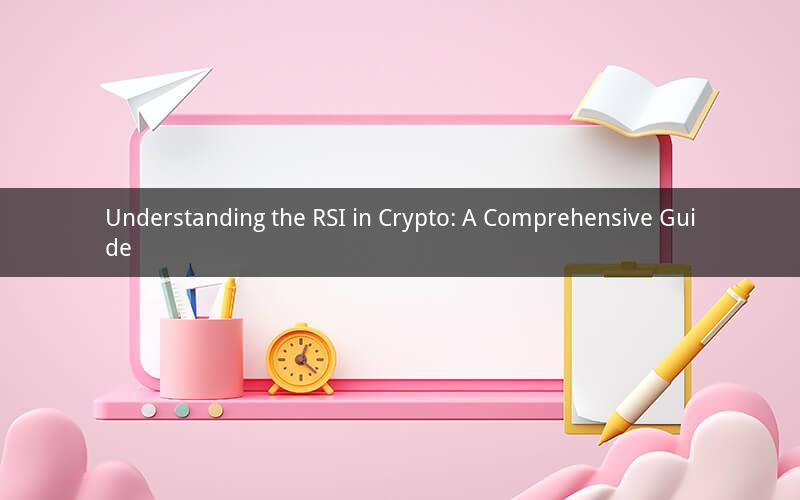
The Relative Strength Index (RSI) is a widely-used momentum oscillator in the world of cryptocurrency trading. It helps traders and investors gauge the current market sentiment and identify potential buying or selling opportunities. In this article, we will delve into the concept of RSI in crypto, its significance, and how it can be effectively utilized in trading strategies.
What is RSI in Crypto?
The RSI is a technical analysis tool that measures the magnitude of recent price changes to evaluate overbought or oversold conditions in a cryptocurrency. It ranges from 0 to 100 and is based on the average gain and loss over a specified period. The RSI is calculated using the following formula:
RSI = 100 - (100 / (1 + RS))
Where RS is the average gain divided by the average loss:
RS = Average Gain / Average Loss
An RSI value above 70 indicates that a cryptocurrency is overbought, suggesting that it may be due for a pullback or correction. Conversely, an RSI value below 30 suggests that a cryptocurrency is oversold, potentially signaling a good entry point for long positions.
The Significance of RSI in Crypto Trading
1. Identifying Overbought and Oversold Conditions
One of the primary uses of RSI in crypto trading is to identify overbought and oversold conditions. When a cryptocurrency's RSI value is above 70, it indicates that the asset has been overbought, and a pullback or correction may be imminent. Conversely, an RSI value below 30 suggests that the asset is oversold, and a potential rally may be on the horizon.
2. Timing Entries and Exits
Traders can use the RSI to time their entries and exits in the market. For example, if a trader identifies an oversold cryptocurrency with an RSI value below 30, they may consider entering a long position. Similarly, if the RSI value is above 70, the trader may opt to exit their long position or take a short position.
3. Confirming Trends
The RSI can also be used to confirm trends in the market. For instance, if a cryptocurrency is in an uptrend, the RSI may remain above 50, indicating that the uptrend is likely to continue. Conversely, if the RSI falls below 50, it may suggest that the uptrend is losing momentum.
4. Avoiding False Signals
While the RSI is a powerful tool, it is important to note that it can generate false signals. Traders should use it in conjunction with other indicators and analysis tools to avoid making impulsive decisions based on a single indicator.
How to Use RSI in Crypto Trading Strategies
1. Overbought/Oversold Strategy
One of the simplest ways to use the RSI is by identifying overbought and oversold conditions. When the RSI is above 70, consider taking profits or exiting a long position. When the RSI is below 30, consider entering a long position or taking a short position.
2. Trend Confirmation Strategy
Combine the RSI with trend lines or moving averages to confirm trends. For example, if a cryptocurrency is in an uptrend and the RSI remains above 50, it may indicate that the uptrend is likely to continue.
3. Divergence Strategy
Divergence occurs when the RSI and the price of a cryptocurrency move in opposite directions. This can be a sign of potential reversals. For instance, if a cryptocurrency is making new highs, but the RSI is failing to reach new highs, it may indicate that the uptrend is losing momentum and a reversal may be imminent.
4. RSI Breakout Strategy
When the RSI breaks above or below a key level, such as 70 or 30, it can signal a strong move in the cryptocurrency's price. Traders can use this information to enter or exit positions.
5. RSI Bounce Strategy
The RSI bounce strategy involves identifying cryptocurrencies that have reached an oversold level (RSI below 30) and are likely to bounce back. Traders can enter long positions at these levels, with the expectation that the price will rise.
Frequently Asked Questions
1. What is the ideal time frame for using the RSI in crypto trading?
Answer: The ideal time frame for using the RSI in crypto trading can vary depending on the trader's strategy and the cryptocurrency being analyzed. Some traders prefer using shorter time frames, such as 14 or 28 periods, while others may opt for longer time frames, such as 50 or 100 periods.
2. Can the RSI be used to predict market tops and bottoms?
Answer: While the RSI can help identify overbought and oversold conditions, it is not a foolproof method for predicting market tops and bottoms. Traders should use it in conjunction with other indicators and analysis tools for a more comprehensive approach.
3. How can I avoid false signals when using the RSI?
Answer: To avoid false signals when using the RSI, traders should consider using it in conjunction with other indicators and analysis tools. Additionally, it is important to be aware of the RSI's limitations and not rely solely on it for making trading decisions.
4. Can the RSI be used for short-term trading or long-term investing?
Answer: The RSI can be used for both short-term trading and long-term investing. However, the time frame and strategy may vary depending on the trader's or investor's objectives and risk tolerance.
5. Is the RSI more effective in certain market conditions?
Answer: The RSI can be effective in various market conditions, but its effectiveness may vary. In highly volatile markets, the RSI may generate more false signals. Traders should be mindful of market conditions and adjust their strategies accordingly.
In conclusion, the RSI is a valuable tool for crypto traders and investors looking to gauge market sentiment and identify potential trading opportunities. By understanding its concept, significance, and various strategies, traders can effectively incorporate the RSI into their trading plans and potentially improve their chances of success in the cryptocurrency market.